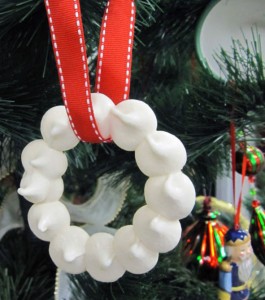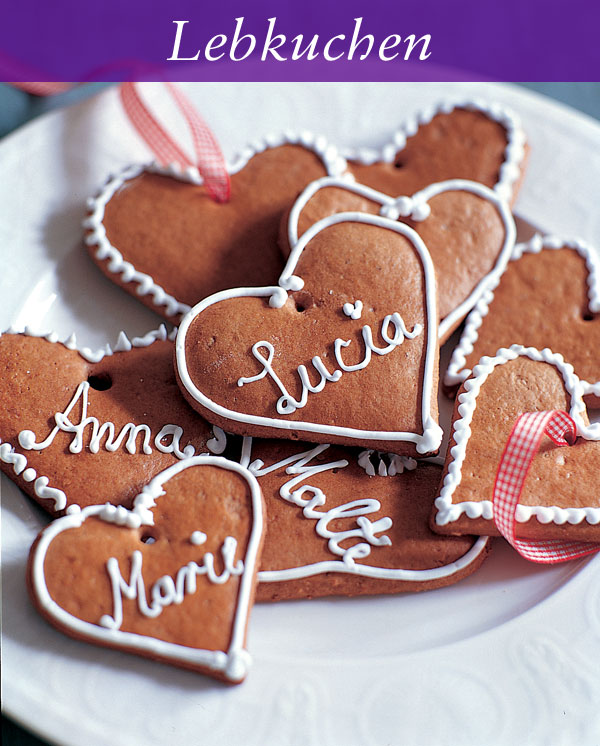In Germany, the Christmas tree is usually put up and decorated on Christmas Eve. Before the wide variety of Christmas ornaments we have today were available, the ‘Tannenbaum’ was adorned with baked goods and real candles, a tradition that many families continue today. Isabelle von Boch shares her family’s favorite recipes so you can start your own Christmas tradition by making these sweet ornaments with your family and trimming the tree together.
These Baiserringe (meringue rings) are still seen on many Christmas trees in Germany. Some are plain, some are decorated lightly with sprinkles. They are hung on the tree with a red ribbon, or simply slipped onto a branch. You may have to make an extra batch as these disappear mysteriously over time!

Baiserringe
Makes 30
Preparation time: 20 minutes
Baking time: 2 hours
These will keep well for about 4 weeks.
Ingredients:
3 egg whites
Pinch of salt
3/4 cup sugar
Method:
1. In a large bowl, mix the egg whites and salt at high speed until stiff. Add the sugar a little a time, continuing to mix until shiny.
2. Preheat the oven to 225F. Line baking trays with parchment paper.
3. Fill a decorating bag fitted with a wide tip (or a plastic bag with one corner cut off) with the egg white, and pipe rings (approx 2 inches in diameter) directly onto the baking tray. If you choose to use sprinkles, decorate the Baiserringe before baking them.
4. Bake them for 2 hours with the oven door slightly ajar. Carefully peel the rings off of the parchment paper and allow to cool.
5. Once cooled, tie ribbon around and place on tree.

Lebkuchen (gingerbread biscuit) cookies have been popular in Germany for hundreds of years. Supposedly, lebkuchen were invented by medieval monks in Germany over five hundred years ago. Traditional lebkuchen is soft, but a harder type of lebkuchen is used to produce these heart cookies decorated with icing that adorn many German Christmas trees and are sold at German Christmas Markets (Striezelmarkt and Christkindlmarkt).
Lepkuchen Hearts (German Gingerbread Hearts)
Makes 25 cookies
Preparation time: 15 minutes
Baking Time: 10 minutes
Allow time for decorating with royal icing
Ingredients:
4 1/2 cups all-purpose flour
1 tbsp. ground cinnamon
2 tsp. ground ginger
1/4 tsp. ground cloves
1 1/4 tsp. baking soda
1/2 cup butter, softened
1/2 cup packed brown sugar
2 large eggs
3/4 cup molasses
Method:
1. Sift dry ingredients (flour, cinnamon, baking soda, ginger and ground cloves) together into a bowl.
2. In a separate bowl, blend butter and brown sugar.
3. Add eggs and molasses.
4. Gradually add the dry ingredients (flour, etc) to the wet ingredients (butter, eggs, molasses and sugar). Stir slowly as you add the ingredients. (The dough will be somewhat stiff.)
5. Divide the dough into two or three even pieces. Flatten each piece with a rolling pin and refrigerate for 1-2 hours (covered in plastic wrap) to ‘firm’ up the dough.
6. Remove from refrigerator and roll out the dough on a floured surface. (If the dough is too tough to roll, let stand at room temperature for 10-15 minutes until it softens.)
7. The dough should be approximately a 1/4 inch. (Don’t worry about being too precise with this measurement.) Cut out heart shapes using cookie cutters or a knife (by tracing around a paper pattern of a heart). Since gingerbread is very hard to roll a second time, try to cut as many cookies as possible from the roll. (Note: it’s possible to bake the ‘leavings’ on a separate cookie sheet. Crumbled gingerbread tastes delicious on yogurt and on ice cream.)
8. Place cookies on a greased cookie sheet and bake at 350 degrees for 10 minutes, until light brown/golden.
9. Once the cookies have cooled, decorate with royal icing. (You can make royal icing yourself or purchase it in pre-made tubes at your local grocery store.)
10. If you need decorating inspiration, try German phrases like “Ich liebe Dich” (I love you) or “Frohe Festtage!” (Happy Holidays) or “Fröhliche Weihnachten!” (Merry Christmas).
